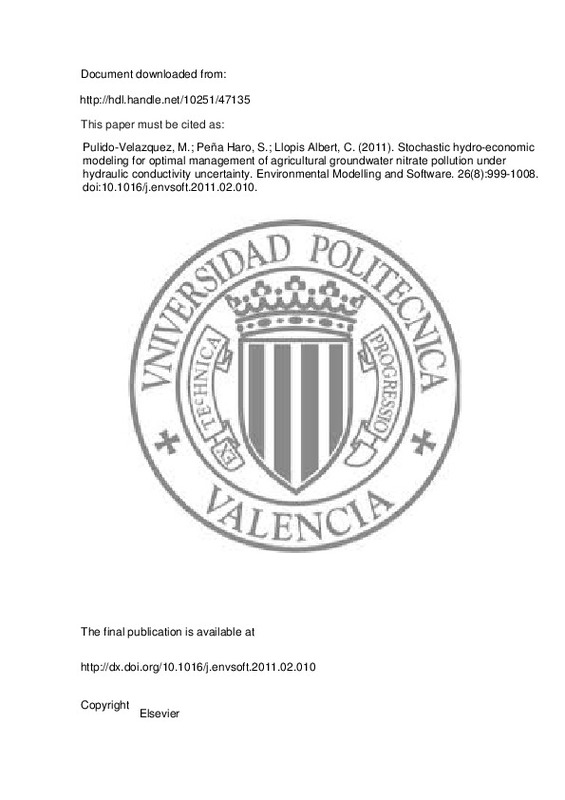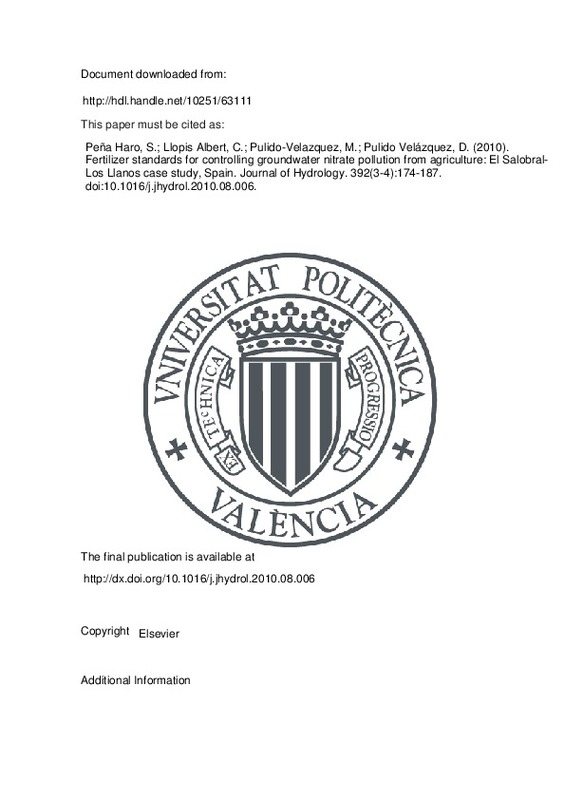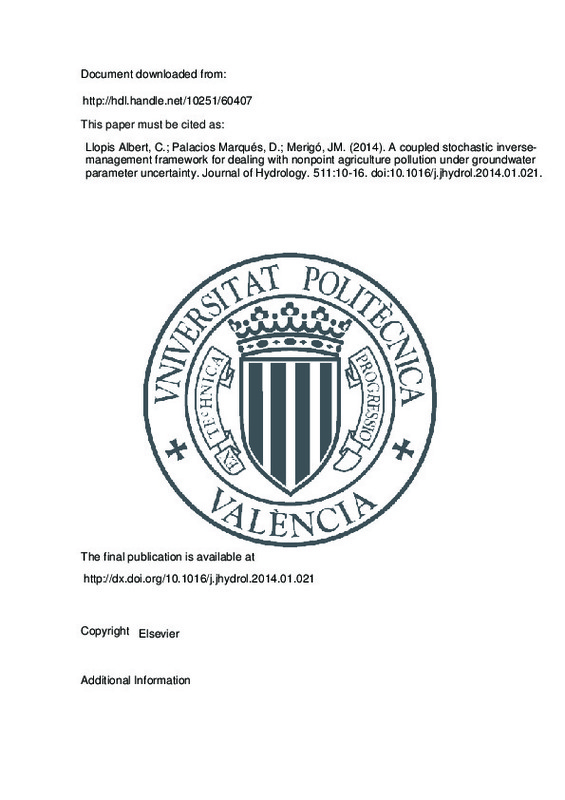JavaScript is disabled for your browser. Some features of this site may not work without it.
Buscar en RiuNet
Listar
Mi cuenta
Estadísticas
Ayuda RiuNet
Admin. UPV
Stochastic hydro-economic modeling for optimal management of agricultural groundwater nitrate pollution under hydraulic conductivity uncertainty
Mostrar el registro sencillo del ítem
Ficheros en el ítem
| dc.contributor.author | Peña Haro, Salvador
|
es_ES |
| dc.contributor.author | Pulido-Velazquez, M.
|
es_ES |
| dc.contributor.author | Llopis Albert, Carlos
|
|
| dc.date.accessioned | 2015-02-16T12:44:38Z | |
| dc.date.available | 2015-02-16T12:44:38Z | |
| dc.date.issued | 2011-08 | |
| dc.identifier.issn | 1364-8152 | |
| dc.identifier.uri | http://hdl.handle.net/10251/47135 | |
| dc.description.abstract | [EN] In decision-making processes, reliability and risk aversion play a decisive role. This paper presents a framework for stochastic optimization of control strategies for groundwater nitrate pollution from agriculture under hydraulic conductivity uncertainty. The main goal is to analyze the influence of uncertainty in the physical parameters of a heterogeneous groundwater diffuse pollution problem on the results of management strategies, and to introduce methods that integrate uncertainty and reliability in order to obtain strategies of spatial allocation of fertilizer use in agriculture. A hydro-economic modeling approach is used for obtaining the allocation of fertilizer reduction that complies with the maximum permissible concentration in groundwater while minimizes agricultural income losses. The model is based upon nonlinear programming and groundwater flow and mass transport numerical simulation, condensed on a pollutant concentration response matrix. The effects of the hydraulic conductivity uncertainty on the allocation of nitrogen reduction among agriculture pollution sources are analyzed using four formulations: Monte Carlo simulation with pre-assumed parameter field, Monte Carlo optimization, stacking management, and mixed-integer stochastic model with predefined reliability. The formulations were tested in an illustrative example for 100 hydraulic conductivity realizations with different variance. The results show a high probability of not meeting the groundwater quality standards when deriving a policy from just a deterministic analysis. To increase the reliability several realizations can be optimized at the same time. By using a mixed-integer stochastic formulation, the desired reliability level of the strategy can be fixed in advance. The approach allows deriving the trade-offs between the reliability of meeting the standard and the net benefits from agricultural production. In a risk-averse decision making, not only the reliability of meeting the standards counts, but also the probability distribution of the maximum pollutant concentrations. A sensitivity analysis was carried out to assess the influence of the variance of the hydraulic conductivity fields on the strategies. The results show that the larger the variance, the greater the range of maximum nitrate concentrations and the worst case (or maximum value) that could be reached for the same level of reliability. © 2011 Elsevier Ltd. | es_ES |
| dc.description.sponsorship | The study has been partially supported by the European Community 7th Framework Project GENESIS (226536) on groundwater systems and from the Plan Nacional I+D+I 2008-2011 of the Spanish Ministry of Science and Innovation (subprojects CGL2009-13238-C02-01 and CGL2009-13238-C02-02). The authors thank the anonymous reviewers for their suggestions for improving the paper. | en_EN |
| dc.language | Inglés | es_ES |
| dc.publisher | Elsevier | es_ES |
| dc.relation.ispartof | Environmental Modelling and Software | es_ES |
| dc.rights | Reserva de todos los derechos | es_ES |
| dc.subject | Fertilizer allocation | es_ES |
| dc.subject | Groundwater | es_ES |
| dc.subject | Nitrates | es_ES |
| dc.subject | Optimization | es_ES |
| dc.subject | Stochastic management model | es_ES |
| dc.subject | Uncertainty | es_ES |
| dc.subject | Agricultural productions | es_ES |
| dc.subject | Agriculture pollution | es_ES |
| dc.subject | Control strategies | es_ES |
| dc.subject | Decision making process | es_ES |
| dc.subject | Deterministic analysis | es_ES |
| dc.subject | Diffuse pollution | es_ES |
| dc.subject | Economic modeling | es_ES |
| dc.subject | Fertilizer use | es_ES |
| dc.subject | Groundwater quality | es_ES |
| dc.subject | High probability | es_ES |
| dc.subject | Illustrative examples | es_ES |
| dc.subject | Management strategies | es_ES |
| dc.subject | Mass transport | es_ES |
| dc.subject | Maximum permissible concentration | es_ES |
| dc.subject | Maximum values | es_ES |
| dc.subject | Mixed-integer | es_ES |
| dc.subject | Monte Carlo optimization | es_ES |
| dc.subject | Monte Carlo Simulation | es_ES |
| dc.subject | Nitrate concentration | es_ES |
| dc.subject | Nitrate pollution | es_ES |
| dc.subject | Nitrogen reduction | es_ES |
| dc.subject | Numerical simulation | es_ES |
| dc.subject | Optimal management | es_ES |
| dc.subject | Physical parameters | es_ES |
| dc.subject | Pollutant concentration | es_ES |
| dc.subject | Reliability level | es_ES |
| dc.subject | Response matrices | es_ES |
| dc.subject | Risk aversion | es_ES |
| dc.subject | Spatial allocation | es_ES |
| dc.subject | Stochastic formulation | es_ES |
| dc.subject | Stochastic management | es_ES |
| dc.subject | Stochastic optimizations | es_ES |
| dc.subject | Worst case | es_ES |
| dc.subject | Agriculture | es_ES |
| dc.subject | Computer simulation | es_ES |
| dc.subject | Decision making | es_ES |
| dc.subject | Fertilizers | es_ES |
| dc.subject | Groundwater flow | es_ES |
| dc.subject | Hydraulic conductivity | es_ES |
| dc.subject | Monte Carlo methods | es_ES |
| dc.subject | Nonlinear programming | es_ES |
| dc.subject | Pollution control | es_ES |
| dc.subject | Probability distributions | es_ES |
| dc.subject | Quality assurance | es_ES |
| dc.subject | Reliability | es_ES |
| dc.subject | Sensitivity analysis | es_ES |
| dc.subject | Standards | es_ES |
| dc.subject | Stochastic models | es_ES |
| dc.subject | Stochastic systems | es_ES |
| dc.subject | Uncertainty analysis | es_ES |
| dc.subject | Water quality | es_ES |
| dc.subject | Groundwater pollution | es_ES |
| dc.subject | Agricultural practice | es_ES |
| dc.subject | Fertilizer application | es_ES |
| dc.subject | Mass transfer | es_ES |
| dc.subject | Monte Carlo analysis | es_ES |
| dc.subject | Nitrate | es_ES |
| dc.subject | Stochasticity | es_ES |
| dc.subject.classification | INGENIERIA MECANICA | es_ES |
| dc.subject.classification | INGENIERIA HIDRAULICA | es_ES |
| dc.title | Stochastic hydro-economic modeling for optimal management of agricultural groundwater nitrate pollution under hydraulic conductivity uncertainty | es_ES |
| dc.type | Artículo | es_ES |
| dc.identifier.doi | 10.1016/j.envsoft.2011.02.010 | |
| dc.relation.projectID | info:eu-repo/grantAgreement/EC/FP7/226536/EU/Groundwater and dependent Ecosystems: NEw Scientific basIS on climate change and land-use impacts for the update of the EU Groundwater Directive/ | es_ES |
| dc.relation.projectID | info:eu-repo/grantAgreement/MICINN//CGL2009-13238-C02-01/ES/Generación y simulación de escenarios futuros de hidrología superficial y subterránea (GESHYDRO)/ | es_ES |
| dc.relation.projectID | info:eu-repo/grantAgreement/MICINN//CGL2009-13238-C02-02/ES/Modelos hidroeconómicos para adaptar la gestión de sistemas de recursos hídricos al cambio climático (HYDROECOCLIMATE)/ | es_ES |
| dc.rights.accessRights | Abierto | es_ES |
| dc.contributor.affiliation | Universitat Politècnica de València. Departamento de Ingeniería Hidráulica y Medio Ambiente - Departament d'Enginyeria Hidràulica i Medi Ambient | es_ES |
| dc.contributor.affiliation | Universitat Politècnica de València. Escuela Técnica Superior de Ingeniería del Diseño - Escola Tècnica Superior d'Enginyeria del Disseny | es_ES |
| dc.description.bibliographicCitation | Peña Haro, S.; Pulido-Velazquez, M.; Llopis Albert, C. (2011). Stochastic hydro-economic modeling for optimal management of agricultural groundwater nitrate pollution under hydraulic conductivity uncertainty. Environmental Modelling and Software. 26(8):999-1008. https://doi.org/10.1016/j.envsoft.2011.02.010 | es_ES |
| dc.description.accrualMethod | S | es_ES |
| dc.relation.publisherversion | http://dx.doi.org/10.1016/j.envsoft.2011.02.010 | es_ES |
| dc.description.upvformatpinicio | 999 | es_ES |
| dc.description.upvformatpfin | 1008 | es_ES |
| dc.type.version | info:eu-repo/semantics/publishedVersion | es_ES |
| dc.description.volume | 26 | es_ES |
| dc.description.issue | 8 | es_ES |
| dc.relation.senia | 219423 | |
| dc.contributor.funder | European Commission | |
| dc.contributor.funder | Ministerio de Ciencia e Innovación |







![[Cerrado]](/themes/UPV/images/candado.png)



